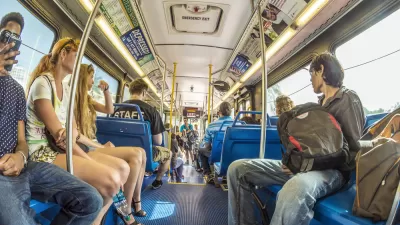An interview with a photographer about his unflattering pictures of train riders in Tokyo's crowded subway.
In his series called "Tokyo Compression," Michael Wolf, took photos of Japanese commuters on crowded trains. According to an interview with Mr. Wolf by CNN's Zahra Jamshed, "Wolf, who lives in Hong Kong, often uses photography to critique the harsh living conditions of large cosmopolitan cities."
"These people are squeezed against the back walls as more and more people are shoveled in. You're living life as a sardine -- it's horrific. This is not a dignified way of living. It's like looking into a ride in hell." Some train riders might point out that all commuters look uncomfortable from time to time as they ride to work. And that, while they might not love the rush hour squeeze, they might not appreciate being photographed at their worst to make the point that they are living in "hell."
But Wolf was intent on capturing the most dramatic and unflattering aspects of the commute. As he explains, "The entire process took four years because the first images I took had no condensation on the windows. The next time I was there, there was more condensation because of the change in season, so the pictures became more dismal and I was able to better express what it was that I wanted."
In the interest of giving Mr. Wolf the benefit of the doubt, he doesn't universally pity all mass transit commuters, later in the interview he allows that, "there are cities around the world that are planned more sensibly." That's almost certainly true, though it's funny to read it in the same outlet which ranked Tokyo's metro system among the 10 best in the world.
FULL STORY: A ride in hell? An up-close look at real life in megacities

Alabama: Trump Terminates Settlements for Black Communities Harmed By Raw Sewage
Trump deemed the landmark civil rights agreement “illegal DEI and environmental justice policy.”

Planetizen Federal Action Tracker
A weekly monitor of how Trump’s orders and actions are impacting planners and planning in America.

The 120 Year Old Tiny Home Villages That Sheltered San Francisco’s Earthquake Refugees
More than a century ago, San Francisco mobilized to house thousands of residents displaced by the 1906 earthquake. Could their strategy offer a model for the present?

In Both Crashes and Crime, Public Transportation is Far Safer than Driving
Contrary to popular assumptions, public transportation has far lower crash and crime rates than automobile travel. For safer communities, improve and encourage transit travel.

Report: Zoning Reforms Should Complement Nashville’s Ambitious Transit Plan
Without reform, restrictive zoning codes will limit the impact of the city’s planned transit expansion and could exclude some of the residents who depend on transit the most.

Judge Orders Release of Frozen IRA, IIJA Funding
The decision is a victory for environmental groups who charged that freezing funds for critical infrastructure and disaster response programs caused “real and irreparable harm” to communities.
Urban Design for Planners 1: Software Tools
This six-course series explores essential urban design concepts using open source software and equips planners with the tools they need to participate fully in the urban design process.
Planning for Universal Design
Learn the tools for implementing Universal Design in planning regulations.
Clanton & Associates, Inc.
Jessamine County Fiscal Court
Institute for Housing and Urban Development Studies (IHS)
City of Grandview
Harvard GSD Executive Education
Toledo-Lucas County Plan Commissions
Salt Lake City
NYU Wagner Graduate School of Public Service




























